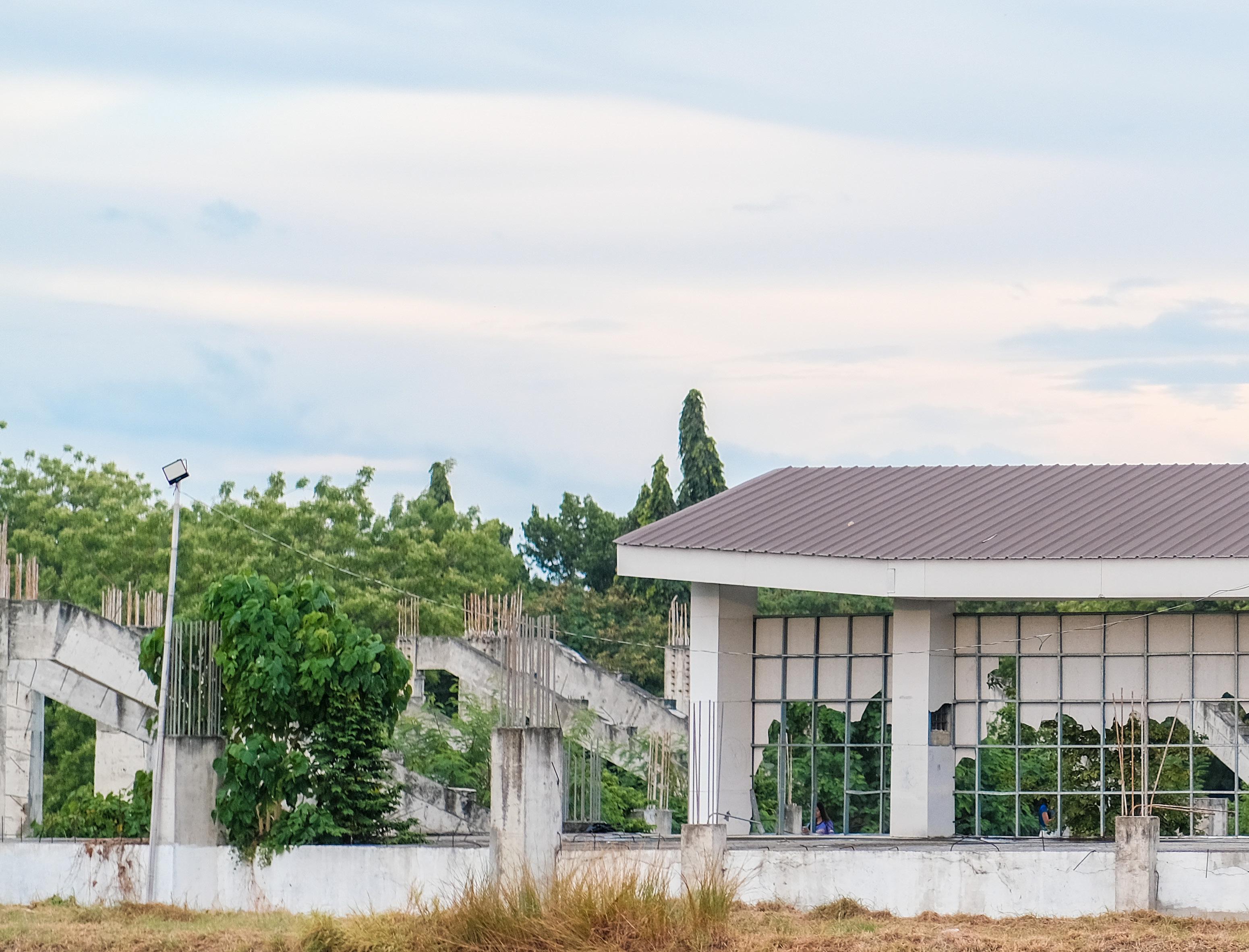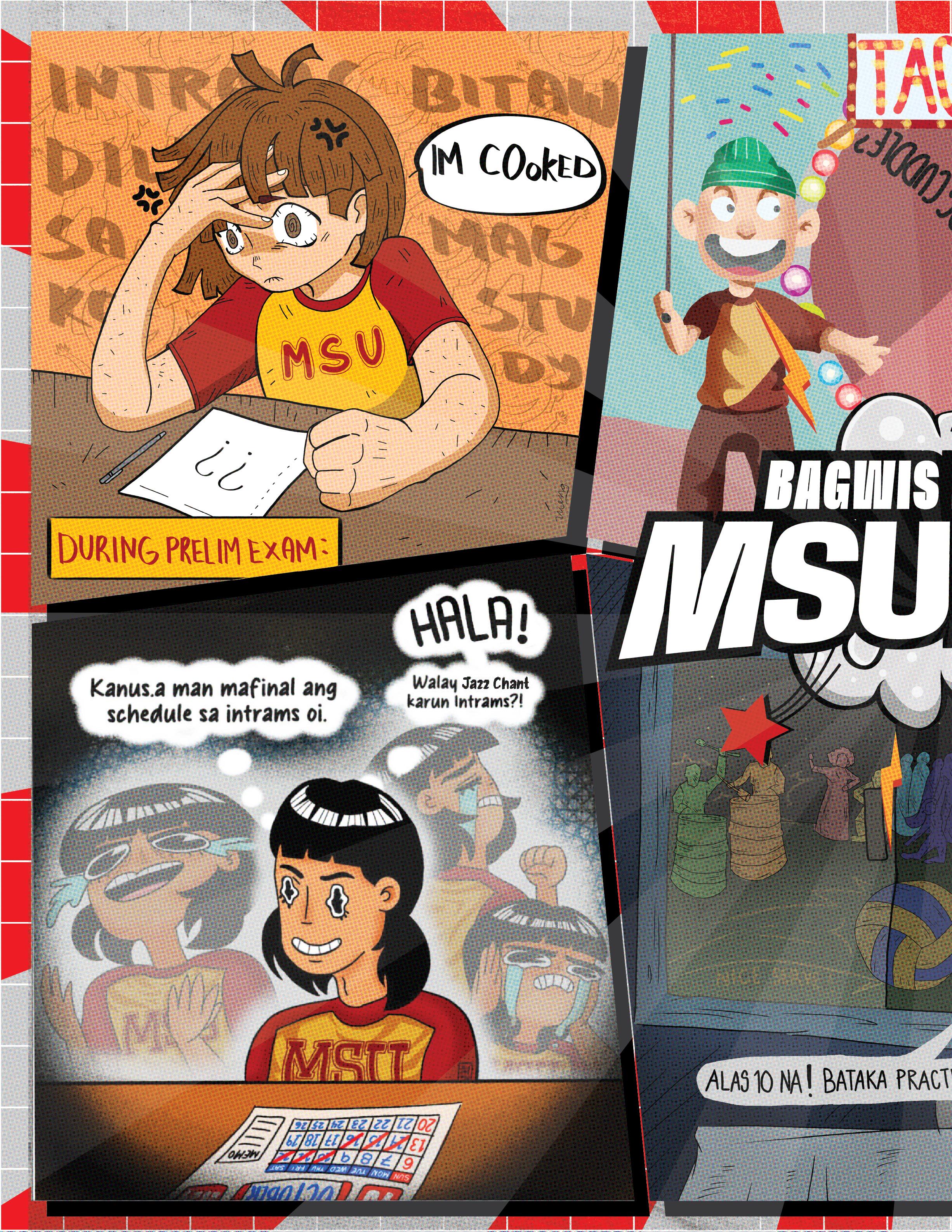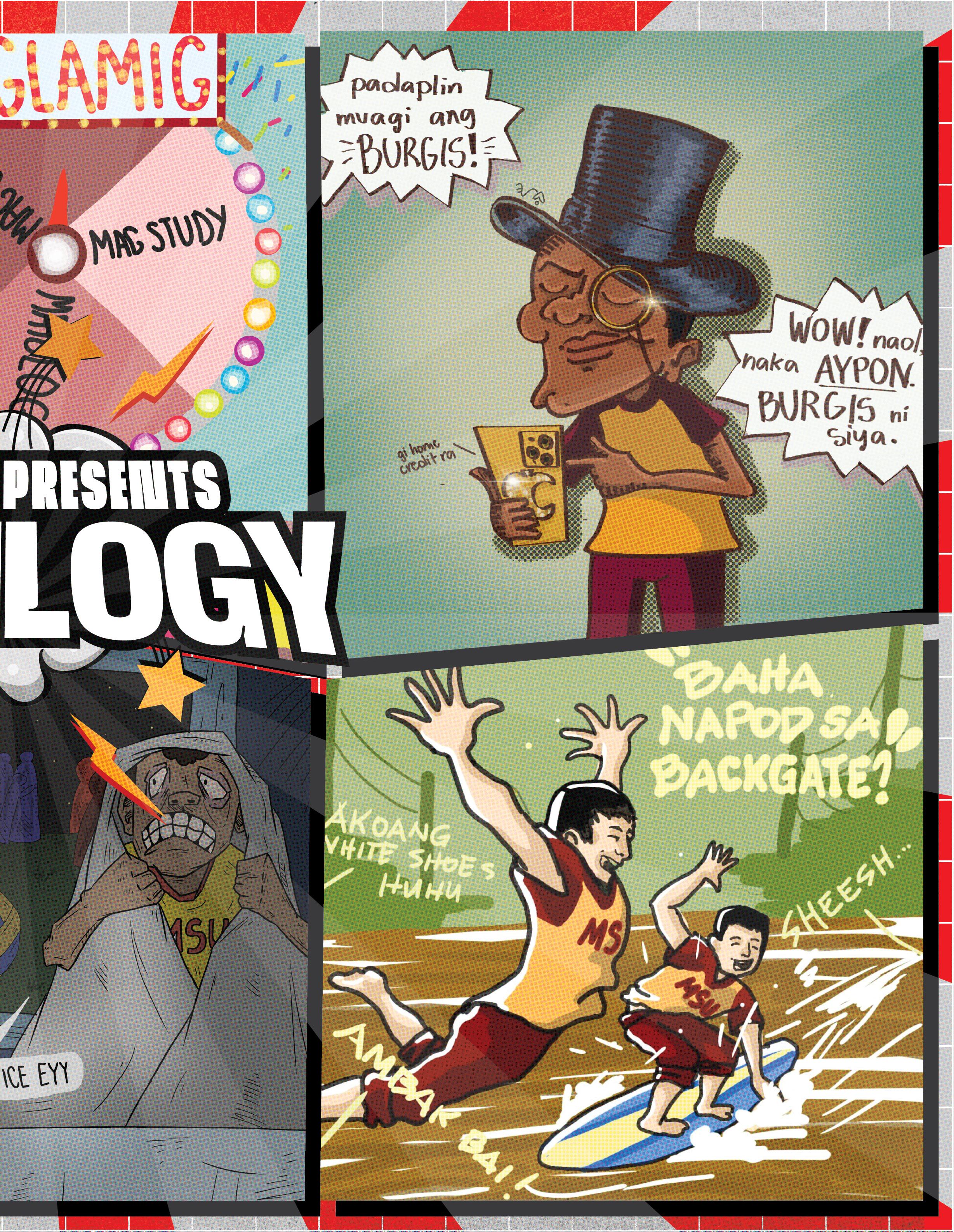



JEROMELEE M. PIANA, JESSIE REY RUERAS





JEROMELEE M. PIANA, JESSIE REY RUERAS
Modules are a matrix of learning, a textbook-screw that helps students tighten their grip on their lessons in their courses; but what should have been a reference of lessons and notes might have just become a reference of additional financial burdens to MSUans in Mindanao State University - General Santos City (MSU - GSC) as these module compilations sit at a price range of ₱300.00 to ₱350.00.
Most often than not, in courses like Readings in Philippine History (GEC105) and History of Filipino Muslims and Indigenous Peoples of MINSUPALA (HIS003), students are required to purchase module compilations to comply with their instructor or professor’s requirements. However, it is not always the case as it still depends on the prerogative of instructors or professors whether to
require the latter from their students. Nevertheless, students still feel compelled to buy compilations so as to not miss out on getting additional points credited by the instructor or professor to those who do.
For MSUans, to see their fellow students selling their used module compilations online is nothing new. If bought directly from the History Department, its prices stand at around ₱300.00, but when bought online, the cost lowers at an enticing price deal. This is an evident consequence owing to their staggering original prices, pushing for second-hand modules to continue gaining traction from students who want to save up money.
In a Facebook post in MemeSU, an unofficial MSU-GSC Facebook group, an anonymous participant wrote about
their experience of failing to purchase a module in GEC105 from the History Department. Apparently, it cost them additional points from their instructor or professor, that would have been merited to them if only they were able to secure a copy of the module. The unnamed user cited their financial struggles as the reason why they were not able to buy the GEC105 module, adding that their father supports their education through his income from being a contractual worker and a sikad driver.
Students struggling financially is a narrative already etched in the fabrics that cradle the story of the common Filipinos, even leading some towards halting their studies. In the currents of the country’s socio-economic status quo, the waves are simply too high for the poor’s wooden boat to set sail and
to fish for food to feed their families. The sky-high prices of basic commodities remain beyond the reach of Filipinos in spite of the Philippines’ August 2024 inflation rate sitting at 3.3%, which has still failed to manifest itself on the conditions of Filipinos struggling to make ends meet. As prices tower over the ₱403.00 (non-agricultural workers) and ₱382.00 (agricultural, service, and retail workers) minimum wages of workers in Region 12, MSUans find themselves unsheathing their money from their pockets, only to barely pull any.
Already grappling with financial difficulties, MSUans heave a sigh of defeat as paying for module compilations in courses like GEC105 or HIS003 take a toll on their money allowances. The problem with this is that these modules are costly, considering the fact among its hundreds of pages, a semester can only cater a few lessons. First year BSED Filipino student Chichay, not her real name, echoed this sentiment, “For me, it’ll be a waste of money gyud.” For her, it is not necessary to buy the modules in its complete form, students can photocopy specific pages that will be tackled in a discussion. She added that ₱300.00 is already a huge sum of money for someone like her who stays in a boarding house near the school. “Big help na kaayo na nga amount,” she stated.
An amount of ₱300.00 can have better uses than being spent on modules. With this amount of money, students can already buy stocks of food for themselves such as rice, which the Philippine Statistics Authority (PSA) reported to cost ₱63.64 per kilogram at the average retail price by the end of August 2024. To add, MSUans will be able to afford two or more medium-sized chicken eggs, reported to cost ₱8.76; or one kilo of refined sugar which costs ₱85.85 according to PSA.
Selling these module compilations in its complete form is, without a doubt, impractical. Pushing through with it
would be insensitive to the financial situations of MSUans. This will only further push them down the sinkhole when in the first place, most of them chose to pursue their undergraduate studies in MSU-GSC to dodge the sharp cuts of paying for tuition fees in college. They not only wanted to get a glimpse of the quality and free education that MSUGSC erected in its fortresses, but also to get a hold of it. When there is a much more practical option, why then must it be tossed away from the conversation?
Although these modules remain important to the learning process of the students, selling them, especially at such a price, is not friendly to the students. Instead of selling them, instructors or professors can just provide their students with soft copies of the modules for their students. Even if they would argue that students need to have a hard copy, surely, it would not hamper the students’ learning competency if they just photocopy the exact pages that their current or upcoming lesson will cover. In that way, students will only have to pay a minimal amount of money.
Helpful as it is, modules are instructional materials at the end of the day. They are integral to the teaching and learning process of professors or instructors and students. However, the distribution of such materials should not be capitalized or if that is not possible, then at least put them up in a price that will not empty the pockets of the students who are already fenced behind the bars of financial burdens such as their everyday baon, back-and-forth fares, projects, college fees, department fees, and for a lot of MSUans, their monthly rent in their boarding houses.
For a lot of iskos and iskas, MSU-GSC was the only road they can take to afford quality education. where they will not have to think of paying for tuition fees. It is, then, the responsibility of those in authority to make sure that this road will remain accessible and free of the barricades that make the poor vulnerable.
“
Students struggling financially is a narrative already etched in the fabrics that cradle the story of the common Filipinos, even leading some towards halting their studies.
JOHN PAUL L. SIAPEL
photo by Katrina B. Elises

Mindanao State University General Santos City (MSU-GSC) along with the Department of Public Works and Highways (DPWH) Region-XII Director Basir M. Ibrahim formally declared the resume of the Phase II of the University Gymnasium construction in the first quarter of 2025, during the signing of the Memorandum of Agreement (MOA) last September 20.
“There was a joint memorandum circular by DPWH kasi, kasi ang project above 5 Million, yung DPWH ang nag implement, and sila yung mag facilitate sa procurement, under sa kanila ‘yung bidding process,” Vice Chancellor for Planning and Development (VCPD), Engr. Randy P. Asturias, said during an interview with Bagwis.
The VPCD confirmed that the DPWH will manage infrastructure projects for state universities and colleges (SUCs) costing over 5 million pesos, including the gymnasium project with a budget allocation of 75 million pesos.
This is in accordance with the DPWHCommission on Higher Education (CHED) Joint Memorandum Circular (JMC) No. 1, series of 2004, which mandated the DPWH to implement such projects.
Engr. Asturias clarified that the second phase was delayed due to lack of funds, prompting the administration to find a new source of budget for its continuation.
“After the completion of the phase one, it took time for the administration to source out the funding to continue the construction of the university gymnasium since Senator Manny was no longer in the government at that time,” he stated.
According to the VCPD, the administration initially planned for the original designer of the gymnasium to continue the project but the proposed design fee cost 18 million, at least 5% of the estimated total project construction.
“Sobrang laki so that’s why nag-decide na lang yung DBM administration na we should create an in-house design and planning team. para imbes mag gastos ng malaki, ma-lessen ang gastos,” he

said.
The VCPD also noted that the project, which was previously handled by DPWH District Office GSC, had been transferred to the DPWH Region-XII after the first phase, causing some revisions in the original design.
In addition, there were also revisions proposed by the in-house design team, headed by Engr. Junlex Tubilid, which included perspective, materials, aesthetics, and an extension of an additional 13 meters from the original design structure among others.
According to Engr. Asturias, the project has already been awarded to the winning contractor and is expected to take at least eight months to one year to finish.
He affirmed that the Phase II is expected to be completed by 2025, consisting of the construction of additional columns, trusses, and roofing.
When asked when the final phase of the gymnasium will commence, the VCPD said its implementation will depend on how fast the administration will source out the budget.
“Maghahanap naman tayo ng another fund na [naman]. Yung sa phase three is, depende talaga sa budget,” he said.
According to Engr. Asturias, it will focus on the construction of bleachers both in the upper and lower boxes, walls, ceilings, complete sanitary, electrical, mechanical and electronic systems, air conditioning, and sports facilities.
He said that the administration will always look for additional funding to finish the construction of the gymnasium.
It can be recalled that last November 2023, the former VCPD Shiela J. Loable stated that the Phase II will start at the second quarter of 2024.


In the midst of what seems like an ocean graveyard, there he stood with a makeshift raft—a compilation of wood bound by weakened tape, an attempt to wash away the dirtied water from his bruised and wounded feet. What lies before him is a sea of disastrous catastrophe; a looming grave of what was once there now buried deep almost six feet under. A single plop of rain sent shivers to his skin, a sudden torrid gale bringing fear to the depth of his bones. This may seem like a narrative fleshed out from a tragic fiction, but really, it is just the vision of a typical Filipino.
Be it a single drop or a bizarre parade

of cats and dogs, what enshrouds the grounds of the Philippines will always be water and the hues of dirt fused in one. And yet, whether it’s how we face the storm unleashed in a series in September or simply feel the agonizing gusts of multiple dilemmas, what will always be seized by the hand of a Filipino is the resilience to return to their drowning home buried from heightened surface.
A resilience that, over the years, has continued to be the pinnacle of what seems like a false light waiting to dim down in the agonies of storms and time.
September waves its hand to say farewell to the lingering fragments of this year’s dry season, and yet what seems to follow in this new chapter is a series of catastrophes, leading to a multitude of floods, thunderstorms, and typhoons. The country’s season does go beyond the four seasons; its intensity within the given months leads to an insufficient preparation for its merciless transitions.
Typhoons have continued to pay a visit to the Philippine Area of Responsibility (PAR), according to the Department of Social
Welfare and Development’s (DSWD’s)
Disaster Response Operations Monitoring and Operations Center (DROMIC). Death tolls continued to rise in numbers during the previous storms, leading to multiple losses and an increase in grievance. This predicament led to the discussion of President Bongbong Marcos Jr.’s State of the Nation Address last July 22, bragging about the 5,500 flood works finished.
Regardless of the many typhoons and their variations of names that enter our lands, what occupies the faces of the Filipinos are the smiles born from unwavering resilience, continuously grappling with the flood that has dominated the news over the past month. But the number of smiles simply cannot tame the winds. Without a doubt, we are left with another conundrum: resilience, yet again, becomes the pill we swallow instead of the effectiveness of flood prevention projects going abuzz since the present administration.
Filipinos have learned only one thing amidst the peak of the rainy season: in order to live, one must play with death.
Although what may surround the Filipinos are endless drops of rain falling in the absence of the ground’s surface, what lingers in their ears is the comfortingly familiar chime of a bell . From there he sought comfort from the shivers of his own hands, the crisp of merciless gusts whispering the tune of holiday melodies— despite the passing cataclysmic days, one tradition remains unsubmerged by the floods, standing as a pillar of hope: the early Christmas season.
The Philippines is known to be the earliest and the longest country to celebrate Christmas, and that itself speaks on the unyielding characteristic of the Filipinos. Despite the many arguments echoing during the peak rainy season, Filipinos have equipped a new way of coping from disasters: the hope that lies within Christmas. We forget about our troubles, driven by resilience, the desperate comfort for our troubled souls.
It seems, however, that our early celebration of Christmas may feed a different part of our brain rather than the joy. At the end of the day, with the current unresolved problems of our environment, what may accompany
our upcoming Noche Buena includes the queso de bola, the grief from the loss of a loved one, and the gifts born from the floods that continued to soak half of our bodies, rendering us stone cold.
There is no storm more violent than the one we carry inside in the absence of peace, echoing a whisper, a sentiment snaring the paradox of our times. This September, celebrated as Peace Consciousness Month, feels odd from the pinnacle of storms landing, to uproars beneath the surface, unrest brews—not just in distant lands, but right here, within our homeland.
In the Philippines, two of the country’s highest seats are occupied by names that once brought political landslides: President Ferdinand Marcos and Vice President Sara Duterte. In just a span of two years, however, their ‘unity’ fades instantly, dividing a once united nation. Meanwhile, across the globe, the Israeli occupation of Palestine continues, battering the idea of peace with winds of oppression.
Yet here we are, celebrating ‘kaPEACEtahan’ in our university, as if these global and local storms don’t exist. Perhaps that is where the challenge lies; celebrating peace in stormy times is not about ignoring the storm, but rather learning how to overcome and stand tall amidst it. As MSUans, part of our roles this month is to confront the pandemonium around us—not solely for compliance with such festivities, but by looking deeper and asking ourselves: What does peace mean when the world is in chaos?
Ironically, these storms attest that peace is not an absence of conflict but the courage to face it head-on, regardless of how strong the storm may rage. The real test of ‘kaPEACEtahan’ is not just the quiet moments, but how we weather the storm— more importantly, what we choose to carry with us when the winds die down. As we stand in the eye of this storm, remember: the winds of change must blow before peace can truly settle.
Riding the Eye of the Intramurals Cloudburst
As the days tick down to the opening ceremony of Intramurals 2024, the storm
clouds overhead paint the brewing tension, evident from the administration’s lastminute changes, with unresolved issues of responsibility.
“Sa tinuod lang, disappointed jud ko,” said a student performer, reflecting on the intense preparations for MSU-GSC’s upcoming intramurals, only to be met with a sudden and unexpected twist: a change in the lineup of events, specifically the Jazz Chant Competition, which was dropped by the administration out of nowhere. It’s clear that students, at least in hindsight, suffered from the laxity of the administration. Unfortunately, this isn’t the first storm looming over the intramurals.
Last year’s event brought a different kind of hurricane—one of garbage mismanagement. The litter management system collapsed, leaving the campus buried under a cyclone of trash—plastic bottles and food wrappers strewn everywhere. University cleaners have nowhere to hide, caught in the aftermath of this garbage storm, left to deal with what the students and the administration we dare say couldn’t—or wouldn’t—manage.
Whether we like it or not, the blame does not rest solely on the administration, but also on us students who litter despite having the privilege of education.
Sure, it is understandable that during every Intramurals, storms in the form of the student and administration passivity are unleashed and very much alive. However, it is incomprehensible that, more often than not, we continue to ride in the eye of these cloudbursts as if they are not destructive, instead of addressing them by criticizing those who deserve scrutiny.
Storms may not come to tamper with an eye that peers within our lands and the blades of wind swallowing us whole, but rather, it is another wave of predicament present in not just the national podium, but even in our status as MSUans. Let this be a ring of a bell, then, a reminder of to what extent does our own unyielding resilience take us, and for how long will this character wear down until we could no longer hold on to its cracked thread.
FAYROUZ OMAR, HEZEL ANN
There was a sparkle when it all began—an unhinged connection between fuss and anticipation. Students were ready to showcase their skills and creativity; their engines revved for the exhilarating journey ahead. However, just as they began to hit their stride, the race abruptly ended, leaving many to wonder why it came to such a sudden halt.
Realizing they’ve been building something all along, only to pause and wonder why the ending arrived before they understood their intended outcome. As quickly as it began, literary events were suddenly pulled away, leaving the participants with only fragments of what might have been something so beautiful.
From the moment the official intramural date was announced, students sprang into action, eager to showcase their talents. Many stayed up late practicing for the literary events, going over plans, and feeding off the burst of excitement fulfilling them. For many, this was not just another school event; it was an opportunity to shine, represent their college, and express their passion.
However, that initial momentum quickly faltered when disappointment settled in as they faced the administration’s decision for a fresh start. In an instant, students who have spent their time, and energy preparing, felt the weight of their effort crumble before them.
“They expect us to just accept it, but this totally recalibrates everything we’ve been practicing for. I hope the administration will be more friendly to the students and try to understand where we’re coming from.” A participant stated expressing his desire for empathy; for the administration to not just hear them, but to feel what they feel, and recognize the truth in their experience. While students are expected to cooperate with the new schedule, there’s an underlying hope that the administration will also take their sacrifices into account.
Caught in the Middle: The Councils’ Crossroads
The situation sparked frustration among
students and placed the councils in a difficult position. They were tasked with navigating the demands of the administration while also addressing the concerns of their fellow students.
A council member expressed how the problem was not about the committee introducing new events, but the late notice of their aim. Efforts were put to waste, and if only they informed them early, it wouldn’t have been such an issue.
While students appreciate the introduction of new activities, the timing of these changes has made it challenging for many. With preparations already underway, another council officer shared, “It’s hard to readjust, especially in our college. The budget for intramurals was crafted based on the previous events, and with some literary events gone, the new ones will be costly, requiring significant paperwork and proper budgeting, though we’ll get by.”
Despite these stops, the councils recognized that both administration and student needs must be balanced. Better communication and timing could have made this transition smoother.
Emergency Stop: The Committee’s Decision
In light of recent concerns about the cancellation of certain literary events at MSU, Sir Monlouie Sorzano, the Director of the University Press and Communications Office (UPCO), clarified that these changes were not due to budget cuts but a strategic decision aimed at improving time management, as past speaking events often exceeded their scheduled durations.
He noted that oration is temporarily canceled, and it is not regarded as lesser but simply due to the abundance of current events. On the other hand, the transformation of Jazz Chant into the new event, Theater-Athlon, as part of their goal to bring a fresh offering to this year’s literary roster. Additionally, last year’s essay and sanaysay events were replaced with Collaborative Desktop Publishing, which effectively combines multiple writing genres into a more cohesive format.
Sorzano acknowledged students’ frustrations, but he advised that it would
have been more strategic to wait for the official guidelines and mechanics. “What if we push this year for Jazz Chant, but let’s say no more music, for example? Just simple chanting, then that would also result in the same adjustments that they are adjusting now in Theater-Athlon,” he added.
He also explained that the “delays” were due to the committee awaiting the legal process for their constitution, as their actions must be contingent on those of the steering committee, and emphasized that they were not behind the schedule, as the expected release of mechanics was aligned with others and the information had been properly communicated to college and student representatives.
Despite these challenges, he shared his enthusiasm for the talent and dedication that students would bring to the stage, expressing his hope that their performances would go beyond mere competition to tackle issues that resonate deeply with them as MSUans and scholars of the nation.
Detours Ahead: Rerouting the Future of Intramurals
As literary competitions draw near, the recent changes to the event lineup evoke the sensation of a race abruptly shifting gears. While evolution is necessary for growth, the abruptness of this shift can leave participants feeling like they’re speeding without the means to slow down.
Less than two weeks is often insufficient for adequate preparation and quality performances. Students are not merely participants; they are individuals passionate about their craft. If the committee genuinely wishes to honor MSU-Gensan’s literary traditions, it is vital to implement changes thoughtfully, transforming what could be a disorienting experience into a celebration of their talents and hard work.
As we move forward, we must remember: progress is best achieved when we steer together, not when we veer off course. The road ahead may be uncharted now, but it’s our shared journey that will determine how we get ready, set, and ultimately navigate the stops along the way.



In a concerted effort to enhance the global contestability of Mindanao State UniversityGeneral Santos City (MSU-GSC), the Sports Development Office (SDO) is exhilarated to introduce beach volleyball, futsal, and pickleball as new events for this year’s Intramurals, scheduled for October 10-15. With these additions, the total number of sporting events rises from 15 to 18, opening new avenues for potential athletes to elevate the university’s reputation in higher levels of competition.
The SDO Director, Professor Sammielyn Lavente, emphasized the significance of these additions noting that these sports were suggested and approved for implementation last year. She highlighted that exhibitions and demonstrations have served as a soft launch, guiding colleges and athletes as they prepare for the upcoming events.
Ensuring a smooth transition into official competition, Prof. Lavente explained that these sports were proposed and justified last year, leading to their approval and implementation in the upcoming Intramural events. She confirmed that exhibition matches were held to help colleges and athletes familiarize themselves with the new sports.
“This initiative will open doors for MSU-Gensan to participate in larger-scale events that we were previously unable to join due to a lack of proper selection avenues,” the SDO Director explained, underscoring the relevance of these sports to the university’s growth. The inclusion of beach volleyball, which enjoyed success in last year’s MSUSAA, prompted its official integration into the Intramural lineup.
Initially showcased as exhibition games, futsal and pickleball are now recognized as competitive sports, confirming their incorporation into the Physical Activities Towards Health and Fitness (PATHFit) curriculum. However, with the introduction of these new sports, concerns regarding the availability of adequate facilities have emerged, particularly since many events typically occur simultaneously in occupied venues.
Despite the excitement, Prof. Lavente clarified that while MSU-Gensan has a beach volleyball court, the establishment of futsal and pickleball courts is still in progress, with all necessary procedures being followed to ensure compliance with regulations. The College of Agriculture’s basketball court will serve as the venue for all futsal matches, while temporary arrangements have been made to host pickleball matches on the lawn tennis courts
until dedicated facilities can be developed.
“The only available location that meets the regulations for a futsal court is the College of Agriculture’s basketball court, which will be utilized for all futsal matches,” Prof. Lavente explained. Currently, the lawn tennis courts will serve as a temporary solution for pickleball matches until permanent courts can be established. The SDO is dedicated to securing appropriate venues for pickleball as the sport continues to gain popularity.
Players are enthusiastic about the new additions to the event slate. Arsahud Binago, a bronze medalist in beach volleyball representing MSU-GSC at the Mindanao State University Athletic Association Unity Games 2024, shared his enthusiasm for the sport’s inclusion, stating, “It was an enriching experience that pushed me to grow both physically and mentally. The unique dynamics of beach volleyball foster a distinct kind of competitiveness, emphasizing communication, trust, and teamwork.” Binago believes this addition will encourage participation from students who might not typically engage in team activities.
Meanwhile, Vea Abellon, a second-year Bachelor of Arts in English Language Studies student-athlete from the College of Social Sciences and Humanities, expressed her excitement for her favorite sport, pickleball. She is grateful that the administration has recognized the sport, noting that although it can be draining and exhausting, the enjoyment it brings is unparalleled; she emphasizes that “it’s all about the passion for learning new things.” Abellon reflected that her college is well-prepared for the upcoming competitions, ready to embrace the challenges ahead.
As the university expands its Intramural offerings, the College of Fisheries (COF) faces significant challenges in recruiting participants and securing essential resources. President Jamel M. Caipang acknowledged these difficulties, noting that many interested players are already committed to other sports; however, to combat the college’s relatively small student population, they have allowed students to compete in multiple events.

Logistical and resource challenges have also emerged for the COF, Caipang highlighted concerns over funding for player jerseys due to a limited budget but noted that they organized officers to distribute solicitation letters to potential sponsors. On a positive note, he reported that they were ‘well-prepared’ with sports equipment, having promptly acquired necessary items once the new events were approved.
Participants have expressed concerns about venue availability for training and equipment shortages, attributing these issues to last year’s budget allocation for sports. However, they are finding innovative solutions to ensure they can perform effectively in competitions, while the SDO Director encourages mass participation from every college, emphasizing that this information has been shared in advance to prepare for the new sporting contests.
Looking ahead, the upcoming athletic games will showcase Arnis as a proposed addition to next year’s roster, with an exhibition set for this year. As MSU-GSC continues to evolve, the enthusiasm surrounding these new sports reinforces the university’s commitment to cultivating a vibrant and competitive athletic community.


AUGUST. FIRST SEMESTER
A.Y. 2024-2025
VOLUME 44 ISSUE 02
AMPLIFYING VOICES DEFENDING FREEDOM PUBLISHING TRUTH